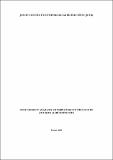| dc.contributor.author | Jesuit Centre for Theological Reflection | |
| dc.date.accessioned | 2020-05-04T07:25:50Z | |
| dc.date.available | 2020-05-04T07:25:50Z | |
| dc.date.issued | 2013-03 | |
| dc.identifier.citation | JCTR. (2013). Cost Benefit Analysis of Employment created by Zambia Agribusiness. Lusaka, Zambia. Jesuit Centre for Theological (JCTR) Reflection | en |
| dc.identifier.uri | https://repository.jctr.org.zm/handle/20.500.14274/73 | |
| dc.description | This cost-benefit analysis was commissioned to assess whether a meaningful relationship has existed between decent employment and investment in a labour intensive sector. Zambia’s agriculture and livestock sector is labour-intensive and significant, it accounted for 86.8% of rural employment, 66.7% of total employment and 12.6% of real GDP in 2011 (CSO, 2012: 113; BOZ, 2012a: 33). The nation also has a large 43 million hectare endowment of arable land as well as ample water resources that can be used for irrigation and hydropower to serve the agriculture sector. However, the sector has been plagued by subpar productivity on account of a lack of technical training among many of the nation’s smallholder farmers. Taken together, these factors make the Zambian agriculture and livestock sector a strategic target for development efforts and investment promotion because it has potential for both poverty alleviation and income generation if productivity is raised to acceptable levels (SNDP, 2010). Hence, the problem evaluated here is whether investment stimulated through government incentives has generated significant decent employment in the agriculture and livestock sector in the period since 1994, the year when special investment incentives were first offered for the sector. | en |
| dc.description.abstract | Zambia is endowed with abundant natural resources, but in spite of the nation’s potential the problems of unemployment, underemployment and poverty have not been meaningfully alleviated by substantial investment and a fast growing economy. Recent economic indicators showed that 84% of the labour force is either unemployed or underemployed in the informal sector, despite the fact that the economy has been growing steadily with a real GDP growth rate above 5% since 2003. The high prevalence of moderate poverty is evidenced by recently released national statistics: moderate poverty stood at 60.5% in 2010 and extreme poverty stood at 42.3% for the same period, and the rates had not improved significantly from the levels reported in 2006. | en |
| dc.language.iso | en | en |
| dc.publisher | Jesuit Centre for Theological Reflection | en |
| dc.rights | Attribution-NonCommercial-ShareAlike 3.0 United States | * |
| dc.rights.uri | http://creativecommons.org/licenses/by-nc-sa/3.0/us/ | * |
| dc.subject | EMPLOYMENT | en |
| dc.subject | AGRIBUSINESSES | en |
| dc.subject | AGRICULTURE | en |
| dc.title | Cost Benefit Analysis of Employment Created By Zambia Agribusiness | en |
| dc.type | Technical Report | en |

